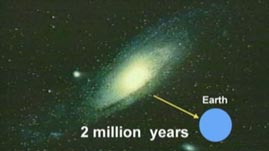Teachers' Domain - Digital Media for the Classroom and Professional Development
User: Preview

Source: Harvard—Smithsonian Center for Astrophysics
In this video segment adapted from Shedding Light on Science, learn how light can be used to measure distance. Meet Kim McLeod, an astronomer at Wellesley College who studies some of the most distant objects in the universe. Even though light appears to travel instantaneously at distances here on Earth, it actually has a measurable speed of about 300,000 km/s. Kim explains how the unit of distance known as a light-year is related to the speed of light, and how the finite speed of light means that the light seen now is really a snapshot of what the object looked like in the past.
The distances between astronomical bodies are so great that they are nearly unimaginable compared to the distances that we are used to in our everyday lives. As a result, when we talk about astronomical distances, typical units of measurement such as kilometers or miles are impractical. For example, Proxima Centauri, the star system closest to our Sun, is 4 x 1013 km (40,000,000,000,000 km) away and the nearest galaxy, the Andromeda Galaxy, is about 2 x 1019 km (20,000,000,000,000,000,000 km) away.
Astronomers have more practical units of measurement, such as the light-year, to describe the vast distances between objects in the universe. Because light does not travel instantaneously—in a vacuum, light travels at a finite speed of about 300,000 km/s (186,000 mi/s)—it takes time for light to travel through the universe. One light-year is equal to the distance that light can travel in one year's time, which is nearly 10 trillion km. Thus, Proxima Centauri is about four light-years away. That means that it takes four years for the light emitted from Proxima Centauri to reach Earth. Andromeda is about two million light-years away—meaning it takes two million years for its light to reach Earth.
In other words, looking at current images of distant astronomical bodies is like looking back in time; the light that we see does not show what the object looks like now but how it looked when the light was emitted. The more distant the object, the longer it takes for its light to reach Earth. Therefore, the deeper you look into space, the farther you look back in time. For example, the Hubble telescope was able to capture optical light from deep space; the Hubble Deep Field image (released in 1996) showed some of the farthest galaxies ever to be seen. Because of the time it has taken the light to travel, the image shows us what the galaxies looked like when they were young. Similarly, the cosmic microwave background (the oldest light in the universe)—which has traveled for almost 14 billion light-years to reach us—shows us how the universe looked when it was very young.
 Loading Standards
Loading Standards Teachers' Domain is proud to be a Pathways portal to the National Science Digital Library.
Teachers' Domain is proud to be a Pathways portal to the National Science Digital Library.
